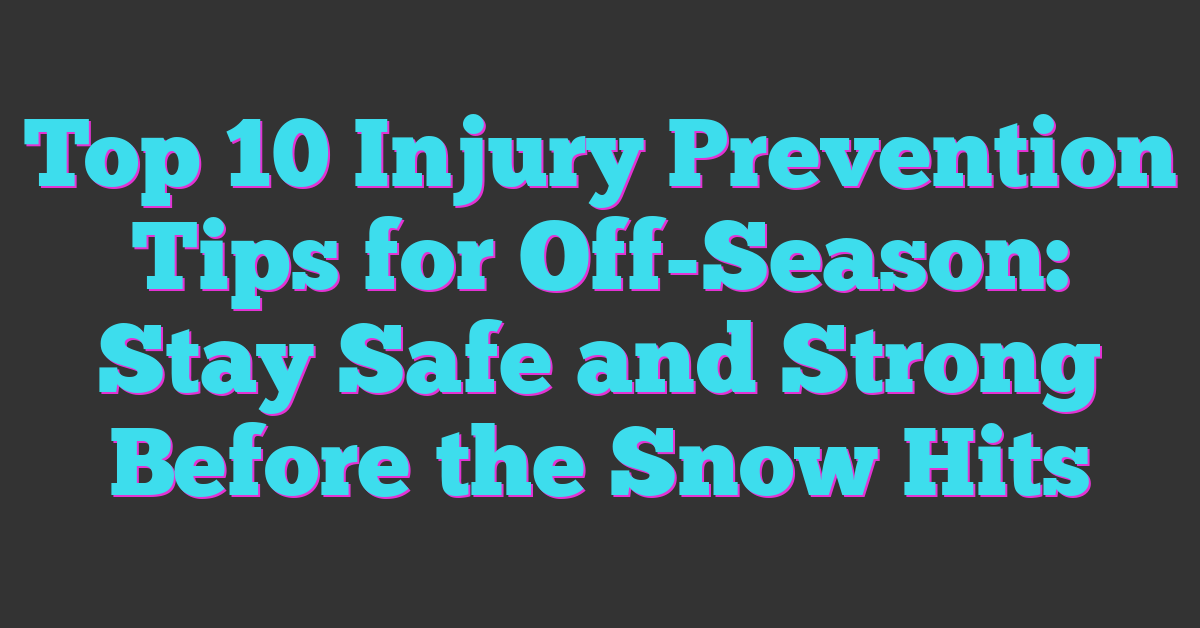The off-season is a golden opportunity for athletes to recharge, but it’s also a time when injuries can sneak up on us. I’ve learned from experience that staying active and engaged during this period is crucial, yet it’s just as important to prioritize safety. With the right strategies, I can keep my body strong and ready for the next season.

Importance of Injury Prevention
Injury prevention is crucial for anyone passionate about snow sports. The thrill of skiing, snowboarding, sledding, or cross-country skiing comes with inherent risks. Injuries can derail plans and cut short the joy of winter sports. I recognize that staying healthy and safe during the off-season lays the foundation for an exciting and successful season.
Maintaining physical activity during the off-season keeps my body conditioned and agile. Engaging in strength training, flexibility exercises, and aerobic workouts helps eliminate weaknesses. Outside of the snow, I focus on cross-training activities such as running, cycling, or swimming. These activities are essential for building endurance and keeping my cardiovascular system robust.
Nutrition plays a vital role in injury prevention. I prioritize a balanced diet rich in vitamins and minerals to support muscle recovery and overall health. Foods high in omega-3 fatty acids, lean proteins, and antioxidants enhance joint health and reduce inflammation. Hydration is equally important; staying well-hydrated keeps my muscles functioning optimally and reduces the risk of cramps or strains.
Proper gear maintenance also contributes to safety. I inspect my skis, snowboards, and sleds regularly to ensure they’re in excellent condition. Blade edges must be sharp and bindings correctly adjusted for maximum control. Using protective gear, such as helmets and pads, significantly reduces the chance of serious injuries.
Listening to my body and respecting its limits is a key principle. I avoid pushing through pain or fatigue, as this increases the risk of injury. Incorporating rest days allows my muscles to recover and adapt. Practicing mindful movements promotes better coordination and balance, essential for navigating various terrains in snow sports.
Incorporating these injury prevention strategies ensures I stay on the slopes, tackling new trails and enjoying every moment of winter sports. Safety and preparation enhance my enthusiasm, allowing me to immerse myself fully in the exhilarating experiences snow sports offer.
Common Off-Season Injuries
As an avid snow sports enthusiast, I know how thrilling winter activities can be, but I also understand the importance of being aware of common injuries during the off-season. Maintaining my physical condition while minimizing the risk of injury is crucial for enjoying the slopes.
Types of Injuries
- Knee Injuries
Knee injuries, like ACL tears and sprains, often occur in skiing and snowboarding due to sudden motions and falls. Strengthening the muscles around the knee through targeted exercises helps mitigate this risk.
- Shoulder Injuries
Injuries to the shoulder, including dislocations and rotator cuff tears, frequently happen from falling or improper landing techniques. Focused shoulder strengthening and mobility exercises can enhance stability.
- Ankle Injuries
Ankle sprains are common, especially in snowboarding. Engaging in ankle stabilization exercises and wearing supportive gear can help protect against these injuries.
- Wrist Injuries
I’ve seen wrist fractures and sprains often occur during falls. Practicing proper falling techniques and using wrist guards can reduce the likelihood of these injuries.
Risk Factors
- Lack of Conditioning
Lack of physical preparation before the season increases the risk of injuries. Incorporating strength, endurance, and flexibility training in the off-season promotes overall fitness.
- Improper Equipment
Using outdated or ill-fitting gear may lead to accidents and injuries. Ensuring that equipment is well-maintained and appropriate for my skill level is crucial.
- Overexertion
Pushing myself too hard without adequate rest can lead to fatigue and injury. Balancing training with recovery ensures my body stays in optimal shape.
- Environmental Conditions
Ice and snow conditions directly impact injury risks. Awareness of weather patterns and slope conditions helps me choose the right times to hit the slopes.
- Inexperience
Inexperienced athletes may lack the skills to fall safely or navigate challenging terrains. Developing skills through supervised training reduces injury risks substantially.
Effective Training Strategies
Staying active during the off-season is essential for any snow sports enthusiast. I’ve found that focusing on effective training strategies not only keeps me in shape but also prepares me for a successful season on the slopes.
Cross-Training Techniques
Cross-training offers variety while enhancing overall fitness. I mix it up with different activities to target various muscle groups and reduce burnout. Here are some techniques I incorporate:
- Running: I enjoy short runs to boost my endurance. This helps maintain cardiovascular fitness crucial for skiing and snowboarding.
- Cycling: I cycle to strengthen my legs and improve stamina. It builds the same muscle groups used in snow sports without the impact on my joints.
- Swimming: Swimming provides a full-body workout. It builds muscle and flexibility while reducing stress on my body.
- Hiking: I take on trails to build leg strength and improve balance. Hiking prepares me for variable terrain on the slopes.
Mixing these activities keeps training exciting and engaging while ensuring I stay in peak form for winter sports.
Flexibility and Strength Training
Flexibility and strength training play vital roles in injury prevention and performance. I prioritize these in my off-season routine. Here’s how I do it:
- Dynamic Stretching: I perform dynamic stretches to improve range of motion before workouts. This warms up my muscles and prepares them for action.
- Yoga: I practice yoga weekly for flexibility and core stability. This enhances balance and coordination, which are critical in snow sports.
- Bodyweight Exercises: I include exercises like squats, lunges, and push-ups to build strength. These exercises mimic movements performed during skiing and snowboarding.
- Resistance Training: I use resistance bands and weights to target specific muscle groups, especially my legs and core. This builds strength and stability, reducing the risk of injuries.
Incorporating these strategies into my off-season training routine not only keeps me fit but also gets me excited for the winter season ahead.
Nutrition and Recovery
Nutrition and recovery play crucial roles in preparing for the upcoming snow sports season. Proper fuel and efficient recovery strategies help me stay on top of my game and minimize injury risk.
Importance of Proper Nutrition
Maintaining a balanced diet during the off-season is essential. A diet rich in whole foods, including lean proteins, whole grains, fruits, and vegetables, supports my muscle recovery and overall health. Consuming protein after workouts helps repair tissue and build strength. Hydration, too, remains critical; I aim for at least 64 ounces of water daily, adjusting based on my activity level. Incorporating nutrient-dense snacks like nuts, yogurt, and smoothies keeps my energy levels steady and fuels those cross-training sessions I enjoy.
Recovery Strategies
Implementing effective recovery strategies enhances my performance and protects against injuries. Active recovery days with low-impact activities like yoga or swimming promote blood flow and flexibility without straining my muscles. I also prioritize sleep, aiming for 7-9 hours nightly, as it facilitates muscle repair and recovery. Regular massages and foam rolling help alleviate muscle tension, promoting better mobility. Lastly, I prefer to listen to my body—if I feel excessive soreness, I allow myself extra rest, ensuring I’m ready for the slopes when the season arrives.
Mental Preparation
Mental preparation plays a critical role in minimizing injuries during the off-season for snow sports. Staying focused and motivated helps maintain an active mindset while preparing for the exhilarating challenges of skiing, snowboarding, sledding, and cross-country skiing.
Mindset for Injury Prevention
Developing a strong mindset can significantly impact injury prevention. I remind myself that an injury can disrupt my entire season, so prioritizing safety is key. Staying aware of my body’s limits keeps me grounded. Watching out for signs of fatigue or discomfort allows me to adjust my activities and avoid risks. I also visualize successful runs and the techniques required to navigate diverse terrain safely. This mental imagery sharpens my skills and reinforces a protective mindset.
Setting Realistic Goals
Setting realistic goals enhances my off-season preparation while keeping my ambitions in check. I focus on specific, attainable objectives that allow for steady progression without risking injury. Examples include aiming to improve my endurance by committing to two weekly cardio sessions or mastering five new yoga poses for flexibility. Tracking these goals in a journal keeps me accountable and motivated. Celebrating small achievements builds confidence and excitement for the upcoming season.
Conclusion
Staying injury-free during the off-season is all about balance. I’ve found that mixing up activities keeps things fresh and exciting while building strength and endurance. Taking the time to focus on nutrition and recovery is just as important as the workouts themselves.
I love setting realistic goals and tracking my progress. It not only keeps me motivated but also helps me stay aware of my limits. Remember to listen to your body and give yourself the rest you need. With the right mindset and preparation, I’m confident we can all head into the next season stronger and ready to tackle those slopes safely.
















